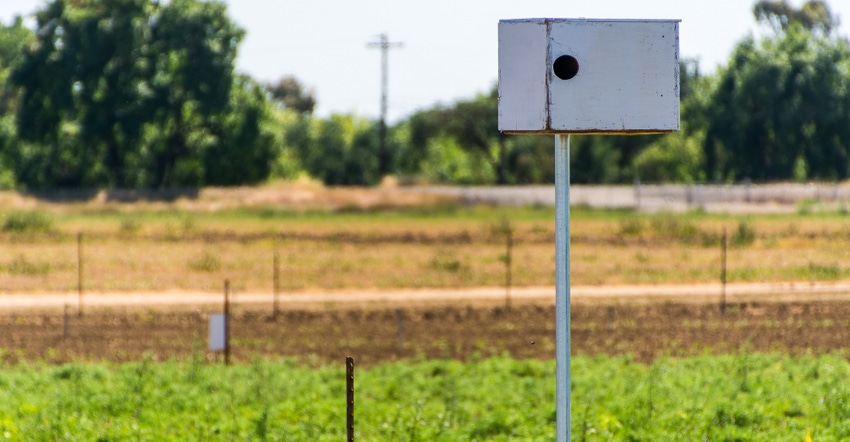
As alfalfa growers consider subsurface drip irrigation (SSDI) to irrigate their crop, the water-thrifty system comes with considerations largely unnecessary with flood-irrigated crops.
Rodent issues can be troublesome in drip-irrigated alfalfa, leading to costly repairs and a need for proactive rodent control. Still, growers can find success in SSDI systems through a focused approach on trapping and integrated pest management practices that include owl boxes and the attraction of song birds for insect control.
Owl boxes that attract barn owls have been shown to reduce gopher, vole and mice populations in alfalfa, according to Dr. Sara Kross, a conservation biologist with Sacramento State University.
Because barn owls are not territorial, the placement of multiple owl boxes at the edge of alfalfa fields can multiply the positive effect, provided there is enough prey for the owls to consume. Boxes for barn owls can be placed about 100 meters apart around the edge of an alfalfa field.
Owl boxes should be painted white to reflect heat and, in most areas, can effectively attract barn owls if placed eight feet above the ground. National Resource Conservation Service guidelines suggest 15 feet, but Kross says they don’t need to be placed that high.
It is important to ensure the hole for the owl is not too large, which can attract the Great Horned Owl and other predators. Owl boxes on poles, rather than in trees, can reduce the likelihood of racoon predation of the nests, she said.
Kross also says that hole size on the box is important when attracting other birds in alfalfa and other cropping systems. Kestrels, a raptor that is territorial, needs boxes spaced about one kilometer apart.
Boxes can be checked for occupancy by visually inspecting them with a camera on a pole or by checking for evidence of feeding on the ground below the boxes. Since barn owls swallow their prey whole, they regurgitate the bones and other materials onto the ground below. Those skeletal remains can be inspected to determine the feeding habits of the owls, she says.
Barn owl boxes should be cleaned annually before Christmas as the owls begin nesting in January. She says this can be easily done by opening the box once the owls are gone and removing the materials left behind. One grower Kross works with uses a carpet remnant that can be easily removed to make dumping the contents easier.
Raptors aren’t the only IPM tool alfalfa farmers can employ. “The take-home message is songbirds are your friends,” Kross continued. Some species of songbird have been found to reduce alfalfa weevil populations by a third, she said.
Trapping
For alfalfa growers seeking other methods of rodent control, Dr. Roger Baldwin, Cooperative Extension specialist at UC Davis, says rodenticides, fumigants and trapping can be moderately to highly effective, depending on method and means used.
Researchers at UC Davis have tested various gopher traps and the Gophinator trap tested better than other traps, Baldwin says.
“It tends to be more effective because it captures larger gophers at a great rate,” he said. “It is better able to hang onto the gopher after it is caught.”
Studies suggest attractants used to entice gophers into traps do not work well, he continued. Human scent does not appear to be a factor in the efficacy of these traps either.
Baldwin recommends trapping be part of any rodent-control IPM program.
Rodenticides – particularly strychnine – can be quite effective if used properly, though gophers can develop resistance to the poison over time and the poison can have secondary impacts on predators that feed on these rodents. Studies in vineyard systems show strychnine to have 100 percent removal of gophers.
Anti-coagulants can work, but efficacy is not consistent, he continued.
Soil fumigants can work as well. Aluminum phosphide can have 80-100 percent effectiveness, but soil moisture needs to be high for the pellets to create their toxic gas.
Gas cartridges can work well for ground squirrels, but don’t work well for gophers, Baldwin says, adding that for gophers, pressurized exhaust machines that inject carbon monoxide into burrow systems can work moderately well. He’s seen between 55-70 percent efficacy with these machines, which have fewer restrictions on their use than does aluminum phosphide tablets.
About the Author(s)
You May Also Like






